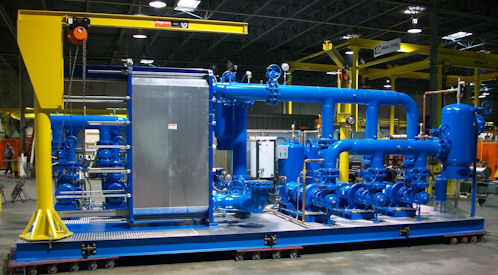The Function of Heat Transfer Equipments in Sustainable Power Solutions for the Future
Heat transfer systems are crucial in the quest for sustainable power remedies. They enhance thermal energy management, enhancing the performance of eco-friendly technologies. By using systems like conduction, radiation, and convection, these systems lessen power losses. Their function in solar thermal and geothermal applications is specifically substantial. As advancements emerge, the possibility for additional advancements elevates important questions concerning future energy methods. What advancements will shape the landscape of sustainable power?
Recognizing Heat Transfer Solutions

The Significance of Thermal Power Management
Effective thermal energy monitoring is necessary for making best use of energy efficiency and decreasing waste in various systems. By controling temperature level and optimizing Heat transfer procedures, companies can markedly reduce power usage and operational costs. Effective management entails the application of advanced innovations and practices that keep track of and manage thermal problems within systems, ensuring that energy resources are made use of effectively. Additionally, appropriate thermal power administration contributes to lowering greenhouse gas emissions, aligning with worldwide sustainability goals. It also boosts system reliability and performance, causing boosted item high quality and longer devices life-span. Ultimately, prioritizing thermal power management is a crucial action towards producing a lot more sustainable energy services and cultivating a liable approach to power consumption in industrial and household contexts.
Applications of Heat Transfer in Renewable Energy
While various renewable power resources guarantee sustainability, the effective application of Heat transfer plays a crucial function in their performance. In wind energy systems, Heat transfer is used for turbine part cooling, improving efficiency and durability. Geothermal energy relies on efficient Heat exchange in between the planet's subsurface and the fluid flowing in the system, making the most of energy removal. Biomass energy procedures also gain from Heat transfer, as it aids in transforming natural materials right into functional fuel with pyrolysis and gasification. In addition, in hydropower, maintaining perfect temperature levels in tanks can improve energy result. Each of these applications shows the essential relevance of Heat transfer systems in enhancing renewable resource modern technologies, ultimately adding to a much more lasting power future.
Enhancing Solar Thermal Power Effectiveness
As solar thermal power systems proceed to progress, boosting their effectiveness has actually ended up being crucial for optimizing power output. Developments in Heat transfer innovations, such as boosted thermal storage products and ingenious Heat exchangers, play a considerable duty in enhancing performance. By making use of advanced products that have exceptional thermal conductivity, systems can transfer and catch Heat more properly. Furthermore, incorporating tracking systems that follow the sun's course warranties that collection agencies receive perfect solar exposure throughout the day. Utilizing nanotechnology in solar absorbers can even more enhance power absorption prices. Incorporating computerized control systems assists regulate temperature levels and take care of power circulation successfully, leading to lowered losses and boosted overall system effectiveness. These improvements lead the method for more sustainable solar thermal energy services in the future.
Geothermal Heating: A Sustainable Service
Geothermal heating provides a sensible alternative for sustainable energy, providing considerable environmental advantages via minimized greenhouse gas exhausts. Its performance and cost-effectiveness make it an eye-catching option to standard furnace. However, challenges connected to execution needs to be dealt with to maximize its possible effect.
Environmental Advantages of Geothermal
Although conventional home heating methods contribute significantly to greenhouse gas discharges, geothermal home heating provides an engaging option that decreases ecological effect. By utilizing the Planet's inner Heat, geothermal systems use a renewable resource source, noticeably minimizing dependence on fossil gas. This technique produces marginal carbon exhausts, making it a cleaner option for commercial and household heating. Furthermore, geothermal systems advertise power performance, as they call for less energy contrasted to conventional heater. DVS Heat Transfer Systems. The usage of geothermal energy additionally aids in reducing air pollution, enhancing regional air top quality and public health. As a sustainable service, geothermal heating supports climate adjustment reduction initiatives, placing itself as an important component in the shift towards a greener future
Effectiveness and Cost-Effectiveness
Just how does geothermal home heating determine up in terms of effectiveness and cost-effectiveness compared to conventional heating unit? Geothermal home heating shows exceptional efficiency, usually attaining a coefficient of efficiency (POLICE) of 3 to 5, indicating it generates 3 to 5 systems of Heat for each unit of power consumed. This performance converts into lower operating prices, particularly in areas with steady geothermal resources. Preliminary installment costs can be greater than conventional systems; nevertheless, lasting cost savings on energy bills and lowered maintenance costs can offset these in advance investments. Furthermore, numerous governments incentivize geothermal systems via refunds and tax obligation credit scores, enhancing their cost-effectiveness. On the whole, geothermal heating arises as a economically practical page and sustainable option to more standard heating remedies.
Implementation Obstacles and Solutions
Various difficulties can restrain the prevalent implementation of geothermal heater, despite their clear benefits as a sustainable power solution. High preliminary installation prices frequently prevent investors and home owners, making funding a significant obstacle. Furthermore, the geographical constraints of suitable geothermal sites limit access in certain regions. Neighborhood regulations and permitting processes can additionally complicate job growth, resulting in delays. Public understanding and understanding of geothermal systems stay low, impeding acceptance. To resolve these obstacles, targeted education and learning campaigns can enhance public knowledge, while federal government motivations can relieve monetary concerns. Collaborating with neighborhood authorities to improve policies may promote smoother job approvals, inevitably promoting the fostering of geothermal home heating as a sensible, these details lasting power choice.
Advancements in Heat Transfer Technologies
Technologies in Heat transfer modern technologies play an essential function in improving energy efficiency and sustainability. Advanced Heat exchangers and phase modification products go to the center of these advancements, supplying substantial enhancements in thermal administration. These innovations not only enhance power usage yet also add to decreasing environmental effect in numerous applications.
Advanced Heat Exchangers
Advanced Heat exchangers play a necessary function in enhancing power efficiency throughout different applications in sustainable power options. These gadgets facilitate the transfer of Heat in between two or even more fluids, significantly reducing power consumption in procedures such as industrial heating, air conditioning, and power generation. Developments in products and design, such as the usage of nanofluids and small configurations, have caused boosted thermal performance and lowered size requirements. Furthermore, innovations in electronic tracking and control systems enable maximized operation, more raising efficiency. By lessening waste Heat and maximizing energy recovery, advanced Heat exchangers add to reduce carbon impacts and sustain the change toward eco-friendly technologies. Their proceeded development is essential for attaining worldwide power sustainability goals.
Stage Change Products
The integration of stage adjustment products (PCMs) right into Heat transfer technologies stands for a substantial development in energy administration and performance. PCMs absorb and release thermal energy throughout their stage changes, allowing reliable temperature level regulation in building materials and energy systems. By storing excess Heat during height durations and launching it when demand rises, PCMs add to load moving and energy conservation - DVS Heat Transfer Systems. This ability improves the performance of renewable energy systems, particularly in solar thermal applications. Additionally, PCMs can her explanation improve the thermal comfort of indoor environments, minimizing dependence on traditional heating and cooling methods. As developments in PCM solutions proceed to arise, their function in sustainable energy services is poised to expand, using appealing avenues for future research study and application

Future Leads for Heat Transfer in Lasting Power
As the demand for lasting energy services continues to rise, the duty of Heat transfer systems is coming to be significantly essential fit future technologies. Advancements in materials and styles are anticipated to boost efficiency in Heat transfer, reducing energy losses in various applications. The combination of sophisticated thermal storage space systems, such as stage change materials and thermochemical storage, will allow much better administration of power resources. Research study right into nanofluids and biomimetic Heat exchangers might even more enhance thermal efficiency. Moreover, the adoption of smart modern technologies will certainly enable real-time monitoring and adaptive control of Heat transfer procedures. These innovations are positioned to considerably add to the overall effectiveness and sustainability of power systems, leading the way for a more energy-efficient future.
Frequently Asked Questions
How Can People Apply Heat Transfer Systems at Home?

People can apply Heat transfer systems at home by mounting energy-efficient home appliances, using radiant home heating, and enhancing insulation. These procedures improve energy performance, minimize costs, and advertise sustainable techniques in property settings.

What Are the Prices Related To Installing Heat Transfer Systems?
The costs connected with installing Heat transfer systems differ extensively, normally including equipment, installation labor, and upkeep. Elements such as system type, home dimension, and neighborhood laws substantially affect the total expense included.
Are There Federal Government Rewards for Heat Transfer System Installations?
Government motivations for Heat transfer system setups vary by area and can consist of tax obligation gives, credit scores, and discounts. These economic advantages aim to motivate adoption, eventually promoting power efficiency and lowering environmental effect within neighborhoods.
How Do Heat Transfer Equipments Effect Power Bills?
Heat transfer systems notably affect energy expenses by optimizing power efficiency. By enhancing the transfer of Heat, these systems lower energy intake, causing reduced energy prices and creating an extra sustainable technique to power administration.
What Upkeep Is Needed for Heat Transfer Solutions?
Upkeep for Heat transfer systems includes regular assessments, cleaning of parts, checking fluid levels, making sure proper insulation, and replacing used parts. These tasks assist keep efficiency, stop breakdowns, and prolong the system's operational life expectancy.
These systems assist in the activity of thermal power from one tool to an additional, enabling the transfer of Heat for heating, power, or air conditioning generation objectives. Geothermal power depends on reliable Heat exchange in between the planet's subsurface and the liquid circulating in the system, making the most of energy removal. Additionally, geothermal systems promote power performance, as they call for much less power contrasted to standard heating systems. Advanced Heat exchangers play a vital duty in enhancing energy performance throughout various applications in lasting power options. Heat transfer systems especially affect energy expenses by maximizing energy efficiency.